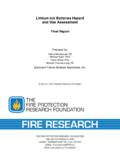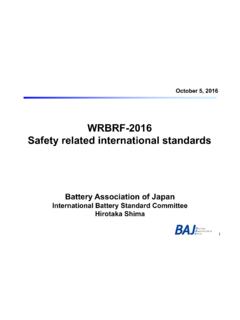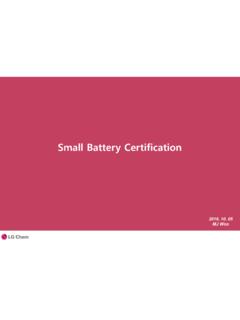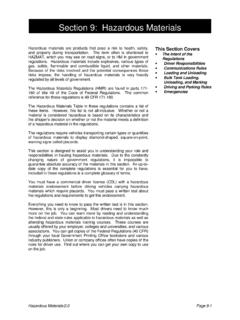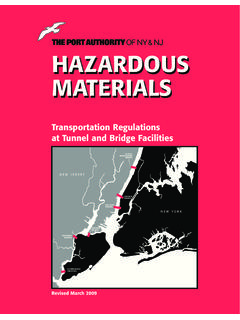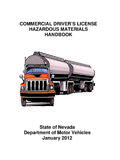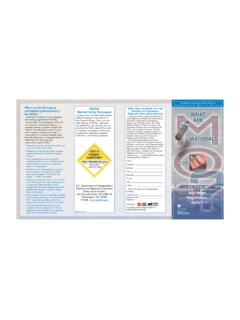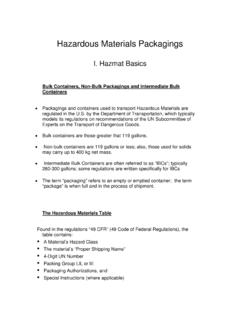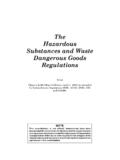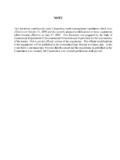Transcription of Batteries in Transport – Applicable U.S. Hazardous ...
1 March 2017. Batteries in Transport . Applicable Hazardous Materials regulations and International Dangerous Goods regulations I. Background: Packaging, Shipping and Testing Batteries PRBA has compiled the information below to provide individuals and companies with an interest in the transportation of Batteries and battery-powered products with a better understanding of the Applicable Hazardous materials regulations and international dangerous goods regulations . In addition, we have provided information on a number of PRBA-member companies and affiliations who offer Hazardous materials consulting, packaging and battery testing services as well as information on the Applicable regulations .
2 Please also note that PRBA's website has two videos on the safe transportation of lithium Batteries and traveling on passenger aircraft with lithium Batteries . See II. What regulations currently apply to shipments of Batteries under the Federal Hazardous materials transportation regulations ? The Pipeline and Hazardous Materials Safety Administration (PHMSA) (a sub-agency of the Department of Transportation (DOT)) is responsible for publishing the Applicable Transport regulations that apply to Batteries as well as other Hazardous materials. Helpful links to these regulations are provided below. In addition, the Federal Aviation Administration (FAA). (another sub-agency of the DOT) has authority to enforce these regulations .
3 49 CFR Subchapter C Hazardous Materials regulations . Click here. 49 CFR Lithium Battery regulations . Click here. 49 CFR Special Provisions 130 and 340 Applicable to dry cell Batteries and nickel metal hydride Batteries . Click here. 49 CFR , Lead Acid Battery regulations . Click here, and here. Shippers of Batteries and battery-powered products also should note that all Batteries , regardless of chemistry ( , alkaline, lithium, lead, nickel metal hydride, carbon zinc, etc., or battery powered products) are subject to 49 CFR (c) in the Hazardous materials regulations . This provision prohibits the offering for transportation or transportation of electrical devices which are likely to create sparks or generate a dangerous quantity of heat, unless packaged in a matter which precludes such an occurrence.
4 If a person offers Batteries or battery powered products that do not comply with 49 CFR (c) they are in violation of the Hazardous materials regulations and may be subject to civil penalties. III. What regulations currently apply to Batteries shipped internationally? Batteries shipped internationally must be packaged in accordance with the International Civil Aviation Organization (ICAO) Technical Instructions and corresponding International Air Transport Association (IATA) Dangerous Goods regulations , and the International Maritime March 2017. Dangerous Goods (IMDG) Code. Other regulations that may apply to international Transport include, but are not limited to, Canada's Transport of Dangerous Goods regulations (TDGR).
5 And European Agreement concerning the International Carriage of Dangerous Goods by Road (ADR). IV. Lithium ion and Lithium Metal Cells and Batteries Lithium ion and lithium metal cells and Batteries are listed as Class 9 Miscellaneous Hazardous materials in the and international Hazardous materials (dangerous goods) regulations and are subject to specific packaging, marking, labeling, and shipping paper requirements. Cells and Batteries also must meet certain testing requirements contained in the United Nations Manual of Tests and Criteria. For a copy of the current UN lithium battery tests, click here. The regulations that govern the Transport of lithium ion and lithium metal cells and Batteries are very complex.
6 Therefore, prior to offering cells and Batteries for Transport , these regulations should be carefully reviewed. Companies that ship lithium Batteries and fail to comply with the Hazardous materials regulations can be assessed substantial civil penalties by the DOT. Shippers of lithium Batteries should consult with Hazardous materials regulatory experts if they do not fully understand the requirements of these regulations . Companies that ship lithium Batteries or products containing them also should immediately determine whether employees preparing packages for Transport are subject to the Hazardous materials/dangerous goods training requirements. V. Lead Acid Batteries Lead acid Batteries are listed as Class 8 Corrosive Hazardous materials in the and international Hazardous materials (dangerous goods) regulations and also are subject to specific packaging, marking, labeling, and shipping paper requirements.
7 Nonspillable lead acid Batteries are provided an exception to the regulations if certain testing and marking requirements are met. These requirements include: 1. The battery must be protected against short circuits and securely packaged;. 2. The battery and outer packaging must be plainly and durably marked NON- SPILLABLE or NON-SPILLABLE BATTERY ;. 3. The battery must be capable of withstanding the following two tests, without leakage of battery fluid from the battery: Vibration test, and Pressure differential rest. 4. At a temperature of 55 C (131 F), the battery must not contain any unabsorbed free- flowing liquid, and must be designed so that electrolyte will not flow from a ruptured or cracked case.
8 A nonspillable lead acid battery that does not meet the testing requirements noted above must be shipped as a Class 8 Corrosive Hazardous material . March 2017. VI. Dry Cell Batteries and Nickel Metal Hydride Batteries Dry cell Batteries , such as alkaline, nickel cadmium, and carbon zinc are not listed as Hazardous materials or dangerous goods in the and international regulations . However, the Batteries must be packed in a manner that prevents the generation of a dangerous quantity of heat and short circuits and packaged in strong outer packaging. There is no official definition of what constitutes a dry cell battery. However, the DOT. has issued numerous interpretation letters over the years confirming that alkaline and nickel cadmium Batteries as dry cell Batteries .
9 (See ). Shippers of dry cell Batteries should review Special Provisions 130 and 340 in the Hazardous materials regulations and Special Provisions A123 and A199 in the IATA Dangerous Goods regulations or ICAO Technical Instructions for additional marking and/or documentation requirements Applicable to these Batteries . Nickel metal hydride Batteries are listed as Class 9 Hazardous materials/dangerous goods (UN3496). When shipped by vessel in quantities over 100 kg they must be shipped as fully- regulated Class 9 Hazardous materials/dangerous goods. (See IMDG Code, Special Provisions 117 and 963.) In all other cases (when shipped via road, rail and air), they may be offered as dry cell Batteries in accordance with the Applicable Special Provisions.
10 VII. Airline Passengers Who Travel with Batteries and Battery Powered Products The Hazardous materials regulations and international dangerous goods regulations have very strict requirements that apply to passengers who carry Batteries and portable electronic equipment on board aircraft. The regulations that govern passengers traveling with Batteries can be found in the Hazardous materials regulations at 49 CFR Exceptions for passengers, crewmembers, and air operators. The regulations are generally consistent with international standards such as the IATA Dangerous Goods regulations . * * * *. A list of additional resources on shipping and traveling with Batteries , the Hazardous materials regulations , and international dangerous goods regulations are provided below.
